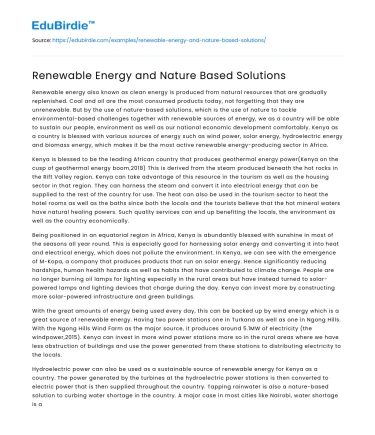Renewable energy also known as clean energy is produced from natural resources that are gradually replenished. Coal and oil are the most consumed products today, not forgetting that they are unrenewable. But by the use of nature-based solutions, which is the use of nature to tackle environmental-based challenges together with renewable sources of energy, we as a country will be able to sustain our people, environment as well as our national economic development comfortably. Kenya as a country is blessed with various sources of energy such as wind power, solar energy, hydroelectric energy and biomass energy, which makes it be the most active renewable energy-producing sector in Africa.
Kenya is blessed to be the leading African country that produces geothermal energy power(Kenya on the cusp of geothermal energy boom,2018) This is derived from the steam produced beneath the hot rocks in the Rift Valley region. Kenya can take advantage of this resource in the tourism as well as the housing sector in that region. They can harness the steam and convert it into electrical energy that can be supplied to the rest of the country for use. The heat can also be used in the tourism sector to heat the hotel rooms as well as the baths since both the locals and the tourists believe that the hot mineral waters have natural healing powers. Such quality services can end up benefiting the locals, the environment as well as the country economically.
Save your time!
We can take care of your essay
- Proper editing and formatting
- Free revision, title page, and bibliography
- Flexible prices and money-back guarantee
Being positioned in an equatorial region in Africa, Kenya is abundantly blessed with sunshine in most of the seasons all year round. This is especially good for harnessing solar energy and converting it into heat and electrical energy, which does not pollute the environment. In Kenya, we can see with the emergence of M-Kopa, a company that produces products that run on solar energy. Hence significantly reducing hardships, human health hazards as well as habits that have contributed to climate change. People are no longer burning oil lamps for lighting especially in the rural areas but have instead turned to solar-powered lamps and lighting devices that charge during the day. Kenya can invest more by constructing more solar-powered infrastructure and green buildings.
With the great amounts of energy being used every day, this can be backed up by wind energy which is a great source of renewable energy. Having two power stations one in Turkana as well as one in Ngong Hills. With the Ngong Hills Wind Farm as the major source, it produces around 5.1MW of electricity (the windpower,2015). Kenya can invest in more wind power stations more so in the rural areas where we have less obstruction of buildings and use the power generated from these stations to distributing electricity to the locals.
Hydroelectric power can also be used as a sustainable source of renewable energy for Kenya as a country. The power generated by the turbines at the hydroelectric power stations is then converted to electric power that is then supplied throughout the country. Tapping rainwater is also a nature-based solution to curbing water shortage in the country. A major case in most cities like Nairobi, water shortage is a major concern. Households can tap rainwater, then store it in reservoir tanks which will then be used for later use. Architects and urban planners can consider this and impart them in their designs which will help in curbing issues of water security as well as water pollution.
Kenya being an agrarian community more so because of the rural areas that mostly depend on farming as the major source of income. Bio mass-energy has huge impacts on the production of heat energy as well as the production of gas for combustion. Such energy is easy to acquire since it is found in animal dung, food waste, human waste and plant waste. In slums human waste and food waste are the major cause of environmental pollution, waste can be collected, put into conservations where they will produce methane gas which is then used for cooking and heating purposes. Similar cases can be applied in institutions and organizations where waste is recycled into methane gas, which is then used for domestic purposes as cooking. This will reduce the use of fuels such as charcoal and petroleum products that cause environmental degradation.
If we manage to use these alternative sources of energy as well as apply these nature-based solutions we will be able to curb most of the environmental challenges that we face as a country as well as have efficient disaster risk management strategies. Since energy is the shadow of our presence in this life.






 Stuck on your essay?
Stuck on your essay?

